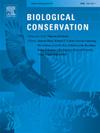Decision analysis shows scientific and economic value of community-based monitoring in Madagascar
IF 4.4
1区 环境科学与生态学
Q1 BIODIVERSITY CONSERVATION
引用次数: 0
Abstract
Community-based monitoring (CBM) could enable long-term biodiversity monitoring in remote areas and benefit local communities, yet is rarely used to facilitate conservation efforts often due to mistrust in the data collected. We use a multi-criteria decision analysis framework to systematically examine the scientific and socioeconomic values and financial costs associated with biodiversity monitoring for vertebrates by scientists and local community members in six protected areas (PAs) in Madagascar, encompassing diverse ecosystems spanning tropical rainforests to spiny deserts. We compare the number of species observed during scientist and community surveys, identify the ‘ideal’ number of scientist and community surveys that would be required to maximize the scientific and socioeconomic values of monitoring efforts while minimizing financial cost, and compare monitoring plans across several conservation philosophies representing “ecocentric” and “people-centered” perspectives. Scientists generally observed more species than community members. However, including a greater proportion of surveys conducted by community members lowered the financial cost of travel and compensation while maximizing ecological and social objectives associated with diverse conservation philosophies. While the valuation schemes we use are simplistic representations of the complex costs and values associated with CBM, this study indicates the benefits of community monitoring regardless of the conservation philosophy used to anchor valuation and decision-making. Increasing integration of CBM into existing conservation management could therefore offer a financially viable method to consistently monitor biodiversity and benefit local communities in the face of limited funding and global challenges.
决策分析显示了马达加斯加社区监测的科学和经济价值
基于社区的监测(CBM)可以使偏远地区的生物多样性长期监测成为可能,并使当地社区受益,但由于对所收集数据的不信任,很少用于促进保护工作。我们使用一个多标准决策分析框架,系统地研究了科学家和当地社区成员在马达加斯加六个保护区(pa)监测脊椎动物生物多样性的科学和社会经济价值以及财务成本,这些保护区包括从热带雨林到多刺沙漠的各种生态系统。我们比较了科学家和社区调查期间观察到的物种数量,确定了最大限度地提高监测工作的科学和社会经济价值,同时最大限度地降低财务成本所需的“理想”科学家和社区调查数量,并比较了代表“生态中心”和“以人为本”观点的几种保护哲学的监测计划。科学家通常观察到的物种比群落成员多。然而,包括更大比例的社区成员进行的调查,降低了旅行和补偿的财务成本,同时最大化了与各种保护理念相关的生态和社会目标。虽然我们使用的评估方案是与CBM相关的复杂成本和价值的简单表示,但本研究表明,无论用于锚定评估和决策的保护理念如何,社区监测都有好处。因此,在资金有限和面临全球挑战的情况下,将CBM纳入现有的保护管理可以提供一种经济上可行的方法来持续监测生物多样性,并使当地社区受益。
本文章由计算机程序翻译,如有差异,请以英文原文为准。
求助全文
约1分钟内获得全文
求助全文
来源期刊

Biological Conservation
环境科学-环境科学
CiteScore
10.20
自引率
3.40%
发文量
295
审稿时长
61 days
期刊介绍:
Biological Conservation is an international leading journal in the discipline of conservation biology. The journal publishes articles spanning a diverse range of fields that contribute to the biological, sociological, and economic dimensions of conservation and natural resource management. The primary aim of Biological Conservation is the publication of high-quality papers that advance the science and practice of conservation, or which demonstrate the application of conservation principles for natural resource management and policy. Therefore it will be of interest to a broad international readership.
 求助内容:
求助内容: 应助结果提醒方式:
应助结果提醒方式:


